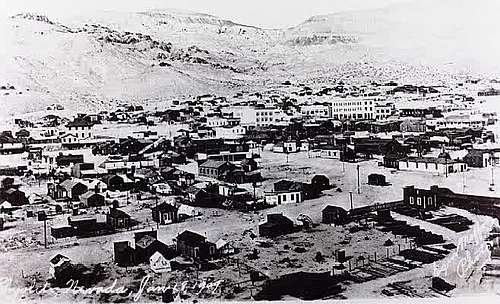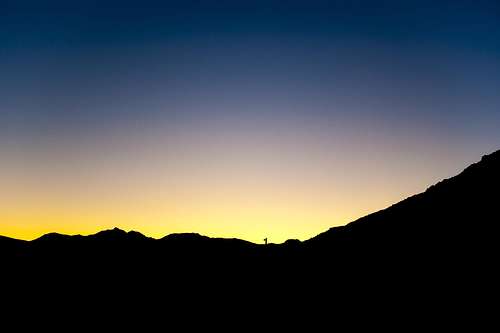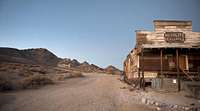-
 4796 Hits
4796 Hits
-
 81.18% Score
81.18% Score
-
 13 Votes
13 Votes
Overview
Rhyolite is a ghost town in Nye County, in the U.S. state of Nevada. It is located in the Bullfrog Hills, about 120 miles (190 km) northwest of Las Vegas, near the eastern edge of Death Valley.History - Part 1
On August 9, 1904, Cross and Harris found gold on the south side of a southwestern Nevada hill later called Bullfrog Mountain. Assays of ore samples from the site suggested values up to $3,000 a ton, or about $71,000 a ton in 2009 dollars when adjusted for inflation. Word of the discovery spread to Tonopah and beyond, and soon thousands of hopeful prospectors and speculators rushed to what became known as the Bullfrog Mining District.Within the district, gold rush settlements quickly arose near the mines, and Rhyolite became the largest. It sprang up near the most promising discovery, the Montgomery Shoshone Mine, which in February 1905 produced ores assayed as high as $16,000 a ton, equivalent to $378,000 a ton in 2009. Starting as a two-man camp in January 1905, Rhyolite became a town of 1,200 people in two weeks and reached a population of 2,500 by June 1905. By then it had 50 saloons, 35 gambling tables, cribs for prostitution, 19 lodging houses, 16 restaurants, half a dozen barbers, a public bath house, and a weekly newspaper, the Rhyolite Herald. Four daily stage coaches connected Goldfield, 60 miles (97 km) to the north, and Rhyolite. Rival auto lines ferried people between Rhyolite and Goldfield and the rail station in Las Vegas in Pope-Toledos, White Steamers, and other touring cars.
Ernest Alexander "Bob" Montgomery, the original owner, and his partners sold the mine to industrialist Charles M. Schwab in February 1906. Schwab expanded the operation on a grand scale, hiring workers, opening new tunnels and drifts, and building a huge mill to process the ore. He had water piped in, paid to have an electric line run 100 miles (160 km) from a hydroelectric plant at the foot of the Sierras to Rhyolite, and contracted with the Las Vegas and Tonopah Railroad to run a spur line to the mine. Three railroads eventually served Rhyolite. The first was the Las Vegas and Tonopah Railroad (LVTR), which began running regular trains to the city on December 14, 1906. Its depot, built in California-mission style, cost about $130,000, equivalent to about $3,070,000 in 2009. About a half-year later, the Bullfrog Goldfield Railroad (BGR) began regular service from the north. By December 1907, the Tonopah and Tidewater Railroad (TTR) began service to Rhyolite on tracks leased from the BGR. The TTR was built to reach the borax-bearing colemanite beds in Death Valley as well as the gold fields.
By 1907, about 4,000 people lived in Rhyolite, according to Richard E. Lingenfelter in Death Valley & the Amargosa: A Land of Illusion. Russell R. Elliott cites an estimated population of 5,000 in 1907–08 in Nevada's Twentieth-Century Mining Boom, noting that "accurate population figures during the boom are impossible to obtain". Alan H. Patera in Rhyolite: The Boom Years states published estimates of the peak population have been "as high as 6,000 or 8,000, but the town itself never claimed more than 3,500 through its newspapers". The newspapers estimated that 6,000 people lived in the Bullfrog mining district, which included the towns of Rhyolite, Bullfrog, Gold Center, and Beatty as well as camps at the major mines.
Rhyolite in 1907 had concrete sidewalks, electric lights, water mains, telephone and telegraph lines, daily and weekly newspapers, a monthly magazine, police and fire departments, a hospital, school, train station and railway depot, at least three banks, a stock exchange, an opera house, and two formal church buildings. Most prominent was the three-story John S. Cook and Co. Bank on Golden Street. Finished in 1908, it cost more than $90,000, equivalent to $2,130,000 in 2009. Much of the cost went for Italian marble stairs, imported stained-glass windows, and other luxuries. The building housed brokerage offices, and a post office, as well as the bank. Other large buildings included the train depot, the three-story Overbury Block, and the two-story eight-room school. A miner named Tom T. Kelly built the Bottle House in February 1906 from 50,000 discarded beer and liquor bottles. Another building housed the Rhyolite Mining Stock Exchange, which opened on March 25, 1907, with 125 members, including brokers from New York, Philadelphia, Los Angeles, and other large cities. The small, modestly equipped storefront listed shares of 74 Bullfrog companies and a similar number of companies in nearby mining districts. Sixty thousand shares changed hands on the first day, and by the end of the second week the number had topped 750,000.
History - Part 2
Although the mine produced more than $1 million (equivalent to about $24 million in 2009) in bullion in its first three years, its shares declined from $23 a share (in historical dollars) to less than $3. In February 1908, a committee of minority stockholders, suspecting that the mine was overvalued, hired a British mining engineer to conduct an inspection. The engineer's report was unfavorable, and news of this caused a sudden further decline in share value from $3 to 75 cents. Schwab expressed disappointment when he learned that "the wonderful high-grade [ore] that had brought [the mine] fame was confined to only a few stringers and that what he had actually bought was a large low-grade mine." Although the mine was still profitable, by 1909 no new ore was being discovered, and the value of the remaining ore steadily decreased. In 1910, the mine operated at a loss for most of the year, and on March 14, 1911, it was closed. By then, the stock, which had fallen to 10 cents a share, slid to 4 cents and was dropped from the exchanges.Rhyolite began to decline before the final closing of the mine. At roughly the same time that the Bullfrog mines were running out of high-grade ore, the 1906 San Francisco earthquake diverted capital to California, and the financial panic of 1907 restricted funding for mine development. As mines in the district reduced production or closed, unemployed miners left Rhyolite to seek work elsewhere, businesses failed, and by 1910, the census reported only 675 residents. All three banks in the town closed by March 1910. The newspapers, including the Rhyolite Herald, the last to go, all shut down by June 1912. The post office closed in November 1913; the last train left Rhyolite Station in July 1914, and the Nevada-California Power Company turned off the electricity and removed its lines in 1916. Within a year the town was "all but abandoned", and the 1920 census reported a population of only 14. A 1922 motor tour by the Los Angeles Times found only one remaining resident, a 92-year-old man who died in 1924.
Impressions
History - Part 3
Much of Rhyolite's remaining infrastructure became a source of building materials for other towns and mining camps. Whole buildings were moved to Beatty. The Miners' Union Hall in Rhyolite became the Old Town Hall in Beatty, and two-room cabins were moved and reassembled as multi-room homes. Parts of many buildings were used to build a Beatty school.The Rhyolite historic townsite, maintained by the Bureau of Land Management, is "one of the most photographed ghost towns in the West". Ruins include the railroad depot and other buildings, and the Bottle House, which the Famous Players Lasky Corporation, the parent of Paramount Pictures, restored in 1925 for the filming of a silent movie, The Air Mail. The ruins of the Cook Bank Building were used in the 1964 film The Reward and again in 2004 for the filming of The Island. Orion Pictures used Rhyolite for its 1987 science-fiction movie Cherry 2000 depicting the collapse of American society. Six-String Samurai (1998) was another movie using Rhyolite as a setting. The Rhyolite-Bullfrog cemetery, with many wooden headboards, is slightly south of Rhyolite.
Tourism flourished in and near Death Valley in the 1920s, and souvenir sellers set up tables in Rhyolite to sell rocks and bottles on weekends. In the 1930s, Revert Mercantile of Beatty acquired a Union Oil distributorship, built a gas station in Beatty, and supplied pumps in other locations, including Rhyolite. The Rhyolite service station consisted of an old caboose, a storage tank, and a pump, managed by a local owner. In 1937, the train depot became a casino and bar called the Rhyolite Ghost Casino, which was later turned into a small museum and curio shop that remained open into the 1970s. In 1984, Belgian artist Albert Szukalski created his sculpture The Last Supper on Golden Street near the Rhyolite railway depot. The art became part of the Goldwell Open Air Museum, an outdoor sculpture park near the southern entrance to the ghost town.
Mining in and around Rhyolite after 1920 consisted mainly of working old tailings until a new mine opened in 1988 on the south side of Ladd Mountain. A company known as Bond Gold built an open-pit mine and mill at the site, about 1 mile (1.6 km) south of Rhyolite along State Route 374. LAC Minerals acquired the mine from Bond in 1989 and established an underground mine there in 1991 after a new body of ore called the North Extension was discovered. Barrick Gold acquired LAC Minerals in 1994 and continued to extract and process ore at what became known as the Barrick Bullfrog Mine until the end of 1998. The mine used a chemical extraction process known as vat leaching involving the use of a weak cyanide solution. The process, like heap leaching, makes it possible to process ore profitably that otherwise would not qualify as mill-grade. Over its entire life, the mine processed about 2,800,000 short tons (2,500,000 t) of ore and produced about 690,000 ounces (20,000 kg) of gold. At 1998 prices, the gold would be worth about $200 million.








